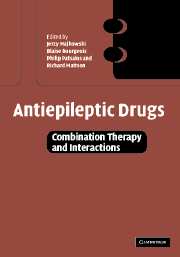Book contents
- Frontmatter
- Contents
- List of contributors
- Foreword
- Foreword
- Acknowledgements
- Part I Introduction
- Part II Pharmacokinetic interactions
- Part III Pharmacodynamic interactions
- Part IV Drug interactions in specific patient populations and special conditions
- Part V Conclusions and future perspectives
- 23 Selection of drug combinations in clinical practice: current and future perspectives
- 24 Future research: an experimental perspective
- 25 Future research: a clinical prospective
- Index
24 - Future research: an experimental perspective
from Part V - Conclusions and future perspectives
Published online by Cambridge University Press: 07 September 2009
- Frontmatter
- Contents
- List of contributors
- Foreword
- Foreword
- Acknowledgements
- Part I Introduction
- Part II Pharmacokinetic interactions
- Part III Pharmacodynamic interactions
- Part IV Drug interactions in specific patient populations and special conditions
- Part V Conclusions and future perspectives
- 23 Selection of drug combinations in clinical practice: current and future perspectives
- 24 Future research: an experimental perspective
- 25 Future research: a clinical prospective
- Index
Summary
Introduction
The previous chapters have amply demonstrated both the need for effective combinations of antiepileptic drugs (AEDs) and the problems associated with the use of such combinations. The first problem is to choose which drugs should be combined and in which dose ratio. To be superior to monotherapy, the drug combination should either act synergistically with respect to the antiepileptic effect or antagonistically with respect to adverse effects, or both. The second major task is assessment of the efficacy of a combination and the experimental demonstration that the efficacy is significantly better than monotherapy.
It is the challenge for basic research:
To provide the theoretical basis to design effective combinations for specific epilepsies.
To provide new tools to assess whether the effect of a combination is synergistic, additive or antagonistic.
In this chapter, we will focus only on achieving maximal synergy for the antiepileptic effect. Alternatively, aiming at achieving maximal antagonism could be applied to minimize adverse effects.
Ultimately, the advantage of a combination of drugs over a single drug can be demonstrated only in in vivo experiments. In vitro experiments are highly useful for the analysis of interactions at specific targets, but can never take into account all aspects that contribute to the final efficacy in the intact organism. Therefore, studies on combination therapy should include both approaches. When designing in vivo experiments and choosing an experimental animal model to demonstrate synergy (or antagonism) of drug combinations, a number of points should be taken into consideration.
Keywords
- Type
- Chapter
- Information
- Antiepileptic DrugsCombination Therapy and Interactions, pp. 441 - 457Publisher: Cambridge University PressPrint publication year: 2005

